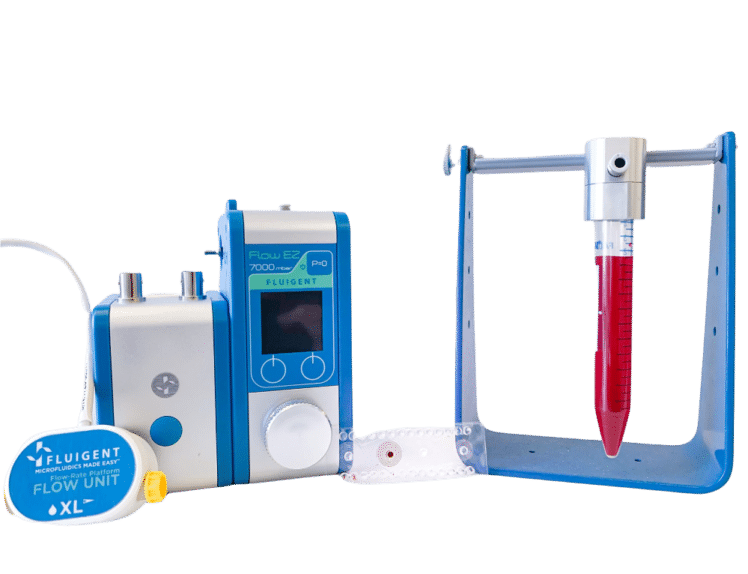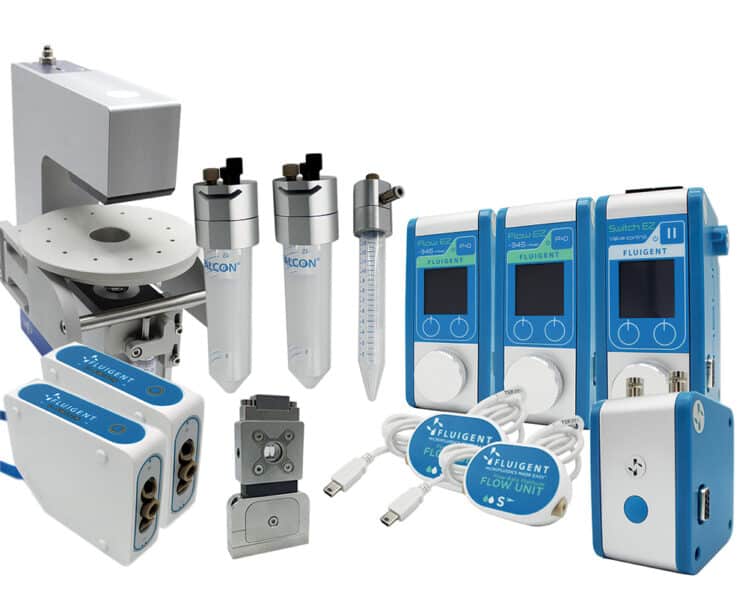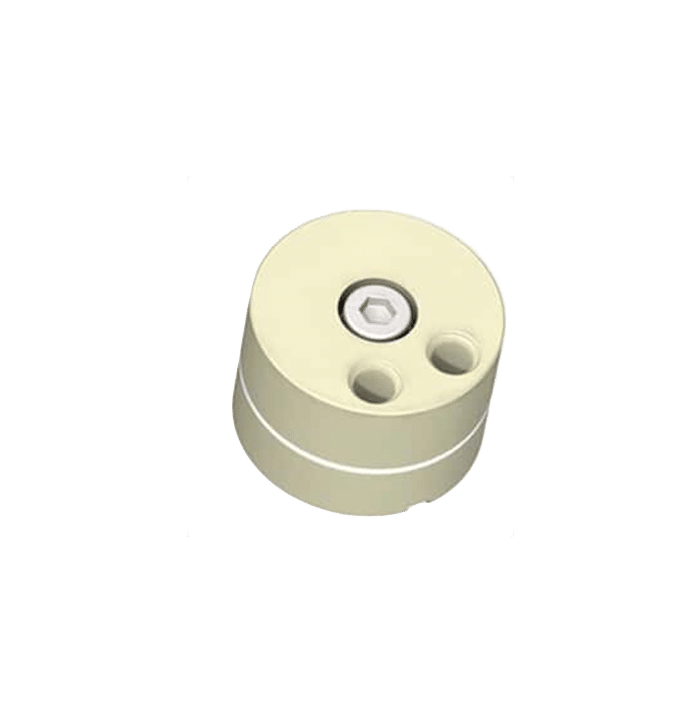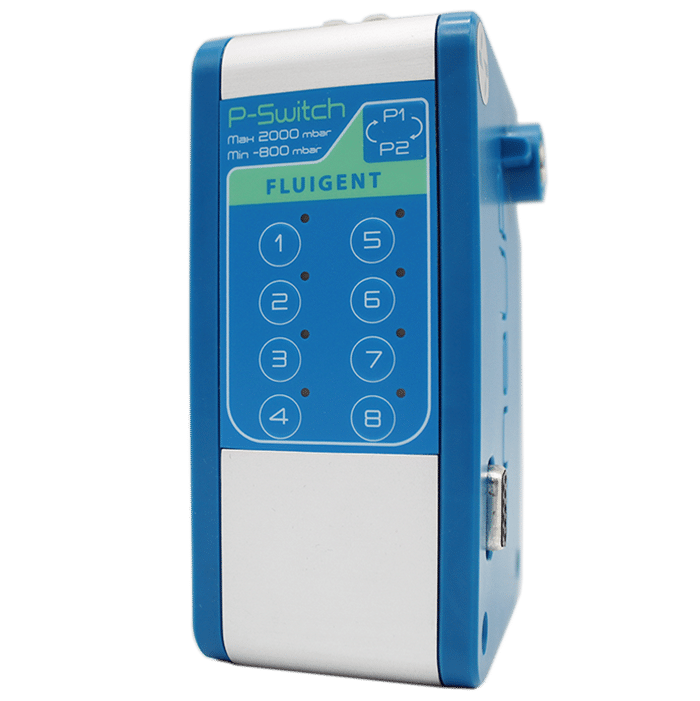Contains the basic connection you need to get started in microfluidics
Connection Box
[CONNEC-BOX]Microfluidic Toolbox
A starter kit for all your microfluidic experiments
This comprehensive toolbox includes a wide range of connectors, tubing, and accessories necessary for conducting microfluidic experiments. It encompasses all the fundamental elements required for any experimental setup, making it an ideal choice for beginners in microfluidics or those seeking to equip themselves adequately for scientific research purposes. Ultimately, this Connection Box is specifically designed to provide the essential tools needed to carry out microfluidic experiments effectively.

- Ideal for beginners
- Versatile
Can be used for all types of microfluidic experiments
- Portable
Tools in a practical and portable box
Features of the Connection Box
Ideal for beginners
The Connection Box contains all the tubing, connectors, and accessories you need to get started in microfluidics. The box will help beginners create their first microfluidic set-ups, based on Fluigent pressure-based flow controller technologies.
Versatile
As it contains different models of tubing and connectors, as well as pressure shut-off valves and pieces for splitting the flow, this microfluidic toolbox will enable you to carry out any type of experiment for any type of application.
Portable
All the elements of the connection starter kit are stored in a practical and portable box. Its modular compartments and compact size make it easy to transport.
How to create a microfluidic setup using Fluigent technology
Fluigent has developed a range of pressure-based flow controllers to meet the need for precise flow rate control and to overcome the problems caused by commonly used systems such as syringe pumps and peristaltic pumps. These products from the LineUp or MFCS series are ideal instruments for your microfluidic setups, since they offer very high fast response times and excellent gas pressure regulation, ensuring excellent flow stability. To realise a microfluidic setup using these pressure controllers, y connection to a source of compressed air and a reservoir containing the fluid is required. The reservoir is then connected to a microfluidic chip, and the fluids will move due to the pressure difference. Additional intruments or accessories can be added depending on the application. You can add a microfluidic flow sensor to control the flow rate or valves to either stop the flow into the microfluidic chip or change between two or more fluids. To avoid bubbles in your microfluidic setup, a bubble trap can be implemented. Also, experiments can be monitored via pressure controllers or using the Oxygen software on a computer. Finally, buiding your setup requires the use of various fittings and microfluidic tubing to connect themicrofluidic device to the various elements of the microfluidic system.

Starting with microfluidics
Microfluidics technologyappeals to both academic researchers and industrial groups. The technology is increasing in popularity as it significantly reduces the need for samples and reagents, shortens experimentation time, and lowers overall application costs. In addition, the miniaturization and automation process facilitated by microfluidics offers a number of advantages, such as improved experimental precision, lower detection limits, and the ability to run multiple analyses simultaneously. By combining the connection box with Fluigent’s packages, users can easily launch experiments such as cell recirculation, sorting experiments or droplet formation.
Access to microfluidic technologies is at your fingertips with Fluigent products.
Starter connection kit contents

Tubing
Working in a microfluidic environment requires the use of microfluidic tubing to connect a device to the various elements of a microfluidic circuit.
When selecting tubing, users should become familiar with the influence of tubing dimensions:
- “OD” means outer diameter.
- “ID” means inner diameter: Diameter of the fluidic path along which fluid flows. The inner diameter plays a significant role in the resistivity generated by the tubing: the smaller it is, the more resistant the tubing will be.
- “L” means length. Usually the tubing is made as short as possible to have smaller internal volumes: the internal volume of the tubing being the inner section multiplied by the length of the tubing. It is also a parameter that takes part in the resistivity of the tubing.
The connection box contains five types of tube made from different materials and with different external and internal diameters, to suit every need.
Connectors, sleeves, and adaptors
To adapt these tubes to all fluigent instruments, the microfluidic toolbox includes a range of connectors, adapters, and sleeves. For example, the green sleeve supplied with the connector starter kit has the right internal diameter to fit a 1/32″ tube, and has an external diameter of 1/16″. This allows a 1/32″ tube to be converted locally into a 1/16″ tube, making it compatible with fittings designed for 1/16″ pipe.
Valve
The Connection Box also contains small valves. These small manual valves can be placed in the microfluidic circuit and can open or close the tube to control fluid flow.
Cross and T junctons
These crossand T-shaped connectors allow the flow to be split into several channels.
Tube cutter
In order to obtain an interface and prevent any clogging or collapse of the fluidic path, all tubing should be cut using specifically designed cutters. One is included in the connector box.
Specifications
Package content
| Tygon tubing 1×3 mm | 3m |
| PEEK tubing 1/32” OD – ID 0.010” (0,25mm) | 3m |
| PEEK tubing 1/32” OD – ID 0.005” (0,13mm) | 3m |
| FEP Tubing 1/16″ OD ID 0,040″ (0,75mm) | 3m |
| FEP Tubing 1/16″ OD ID 0,020″ (0,5mm) | 3m |
| FEP Tubing 1/16″ OD ID 0,010″ (0,25mm) | 3m |
| Sleeve 1/16″ – 1/32″ | 5 |
| Flangeless fitting 1/4-28 and blue ferrule | 5 |
| Adapter 10/32 | 4 |
| Tubing reducer 1/16” – 1/32” | 2 |
| PEEK black plug 1/4-28 | 5 |
| Fluidic cross Junction | 2 |
| Fluidic T Junction | 2 |
| Manual fluidic valve | 2 |
| Tubing cutter | 1 |
| Box | 1 |
Related products

Microfluidic Recirculation Pack
See the offer
Microfluidic Size Cell Sorting Pack
See the offer
Double Emulsion Generation Pack
See the offer
Microfluidic Flow Control System
See the offer
Bubble Trap
See the offer
Microfluidic Push Pull controller
See the offer
Microfluidic valve controller for flow redirection
See the offer
Pressure Reducer for Mixed Pressure Range Modules
See the offer
Microfluidic Software Control
See the offer
Pneumatic Valve Controller
See the offer
Expertise & resources
-
Fluigent Products Datasheets Connection Box Datasheet Download
-
Expert Reviews: Basics of Microfluidics Choosing the Right Microfluidic Pressure Range Read more
-
Expert Reviews: Basics of Microfluidics How to choose a microfluidic chip Read more
-
Microfluidics White Papers An exploration of Microfluidic technology and fluid handling Read more
-
Expert Reviews: Basics of Microfluidics Microfluidics overview: History and Definition Read more




